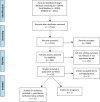Systematic review of melanoma incidence and prognosis in solid organ transplant recipients
- PMID: 24834346
- PMCID: PMC4022534
- DOI: 10.1186/2047-1440-3-10
Systematic review of melanoma incidence and prognosis in solid organ transplant recipients
Abstract
Cutaneous melanoma carries the potential for substantial morbidity and mortality in the solid organ transplant population. We systematically reviewed the literature published from January 1995 to January 2012 to determine the overall relative risk and prognosis of melanoma in transplant recipients. Our search identified 7,512 citations. Twelve unique non-overlapping studies reported the population-based incidence of melanoma in an inception cohort of solid organ transplant recipients. Compared to the general population, there is a 2.4-fold (95% confidence interval, 2.0 to 2.9) increased incidence of melanoma after transplantation. No population-based outcome data were identified for melanoma arising post-transplant. Data from non-population based cohort studies suggest a worse prognosis for late-stage melanoma developing after transplantation compared with the general population. For patients with a history of pre-transplant melanoma, one population-based study reported a local recurrence rate of 11% (2/19) after transplantation, although staging and survival information was lacking. There is a need for population-based data on the prognosis of melanoma arising pre- and post-transplantation. Increased incidence and potentially worse melanoma outcomes in this high-risk population have implications for clinical care in terms of prevention, screening and reduction of immunosuppression after melanoma development post-transplant, as well as transplantation decisions in patients with a history of pre-transplant melanoma.
Keywords: Cancer; Epidemiology; Incidence; Malignancy; Melanoma; Neoplasia; Prognosis; Registry; Transplant.
Figures
Similar articles
-
Melanoma incidence, stage, and survival after solid organ transplant: A population-based cohort study in Ontario, Canada.J Am Acad Dermatol. 2020 Sep;83(3):754-761. doi: 10.1016/j.jaad.2019.09.072. Epub 2020 Feb 25. J Am Acad Dermatol. 2020. PMID: 32111554
-
Kidney and liver organ transplantation in persons with human immunodeficiency virus: An Evidence-Based Analysis.Ont Health Technol Assess Ser. 2010;10(4):1-56. Epub 2010 Mar 1. Ont Health Technol Assess Ser. 2010. PMID: 23074407 Free PMC article.
-
[Melanoma in organ transplant patients].Ann Dermatol Venereol. 2000 Feb;127(2):160-5. Ann Dermatol Venereol. 2000. PMID: 10739973 French.
-
A narrative review on the outcome of primary cutaneous melanomas arising in solid organ transplant recipients.Eur J Dermatol. 2021 Jun 1;31(3):364-371. doi: 10.1684/ejd.2021.4067. Eur J Dermatol. 2021. PMID: 34080979
-
Cutaneous melanoma in solid organ transplant patients.G Ital Dermatol Venereol. 2014 Aug;149(4):389-94. G Ital Dermatol Venereol. 2014. PMID: 25068225 Review.
Cited by
-
Hmgb1 inhibits Klotho expression and malignant phenotype in melanoma cells by activating NF-κB.Oncotarget. 2016 Dec 6;7(49):80765-80782. doi: 10.18632/oncotarget.12623. Oncotarget. 2016. PMID: 27779100 Free PMC article.
-
A Possible Association between Melanoma and Prostate Cancer. Results from a Case-Control-Study.Cancers (Basel). 2015 Apr 15;7(2):670-8. doi: 10.3390/cancers7020670. Cancers (Basel). 2015. PMID: 25884238 Free PMC article.
-
Malignant Melanoma in a Retrospective Cohort of Immunocompromised Patients: A Statistical and Pathologic Analysis.Cancers (Basel). 2023 Jul 13;15(14):3600. doi: 10.3390/cancers15143600. Cancers (Basel). 2023. PMID: 37509262 Free PMC article.
-
Health Consequences of Thymus Removal in Adults.N Engl J Med. 2023 Aug 3;389(5):406-417. doi: 10.1056/NEJMoa2302892. N Engl J Med. 2023. PMID: 37530823 Free PMC article.
-
Antitumor activity of nivolumab on hemodialysis after renal allograft rejection.J Immunother Cancer. 2016 Oct 18;4:64. doi: 10.1186/s40425-016-0171-8. eCollection 2016. J Immunother Cancer. 2016. PMID: 27777773 Free PMC article.
References
-
- Sheil AG. Development of malignancy following renal transplantation in Australia and New Zealand. Transplant Proc. 1992;24(4):1275–1279. - PubMed
Publication types
LinkOut - more resources
Full Text Sources
Other Literature Sources



